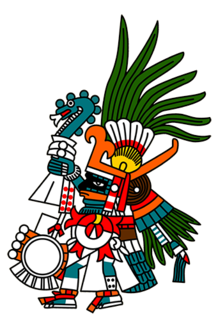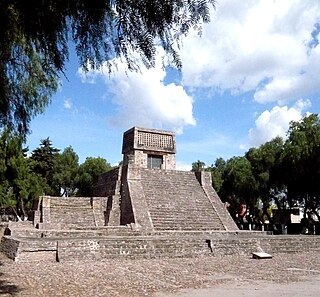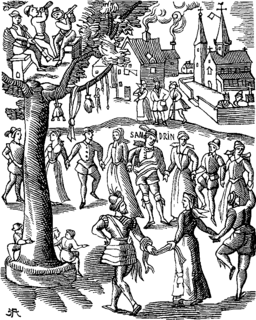
In the Aztec religion, Huitzilopochtli is a deity of war, sun, human sacrifice, and the patron of the city of Tenochtitlan. He was also the national god of the Mexicas, also known as Aztecs, of Tenochtitlan. Many in the pantheon of deities of the Aztecs were inclined to have a fondness for a particular aspect of warfare. However, Huitzilopochtli was known as the primary god of war in ancient Mexico. Since he was the patron god of the Mexica, he was credited with both the victories and defeats that the Mexica people had on the battlefield. The people had to make sacrifices to him to protect the Aztec from infinite night. He wielded Xiuhcoatl as a weapon, associating him with fire.

In Aztec religion, Huixtocihuatl was a fertility goddess who presided over salt and salt water. The Aztecs considered her to be the older sister of the rain gods, including Tlaloc. Much of the information known about Huixtocihuatl and how the Aztecs celebrated her comes from Bernardino de Sahagún's manuscripts. His Florentine Codex explains how Huixtocihuatl became the salt god. It records that Huixtocihuatl angered her younger brothers by mocking them, so they banished her to the salt beds. It was there where she discovered salt and how it was created. As described in the second book of the Florentine Codex, during Tecuilhuitontli, the seventh month of the Aztec calendar, there was a festival in honor of Huixtocihuatl. The festival culminated with the sacrifice of Huixtocihuatl's ixiptla, the embodiment of the deity in human form.

Mesoamerican calendars are the calendrical systems devised and used by the pre-Columbian cultures of Mesoamerica. Besides keeping time, Mesoamerican calendars were also used in religious observances and social rituals, such as for divination.

Codex Ríos is an Italian translation and augmentation of a Spanish colonial-era manuscript, Codex Telleriano-Remensis, that is partially attributed to Pedro de los Ríos, a Dominican friar working in Oaxaca and Puebla between 1547 and 1562. The codex itself was likely written and drawn in Italy after 1566.

The Xiuhpōhualli was a 365-day calendar used by the Aztecs and other pre-Columbian Nahua peoples in central Mexico. It was composed of eighteen 20-day "months," called veintenas or mētztli with a separate 5-day period at the end of the year called the nemontemi. Whatever name that was used for these periods in pre-Columbian times is unknown. Through Spanish usage, the 20-day period of the Aztec calendar has become commonly known as a veintena. The Aztec word for moon is mētztli, and this word is today to describe these 20-day periods, although as the sixteenth-century missionary and early ethnographer, Diego Durán explained:
In ancient times the year was composed of eighteen months, and thus it was observed by these Indian people. Since their months were made of no more than twenty days, these were all the days contained in a month, because they were not guided by the moon but by the days; therefore, the year had eighteen months. The days of the year were counted twenty by twenty.

Aztec medicine concerns the body of knowledge, belief and ritual surrounding human health and sickness, as observed among the Nahuatl-speaking people in the Aztec realm of central Mexico. The Aztecs knew of and used an extensive inventory consisting of hundreds of different medicinal herbs and plants. A variety of indigenous Nahua and Novohispanic written works survive from the conquest and later colonial periods that describe aspects of the Aztec system and practice of medicine and its remedies, incantations, practical administration, and cultural underpinnings. Elements of traditional medicinal practices and beliefs are still found among modern-day Nahua communities, often intermixed with European or other later influences.
Tozoztontli is the name of the third month of the Aztec calendar. It means Little Perforation. It is also a festival in the Aztec religion, the deities are Centeotl, Tlaloque, Chicomecoatl and Coatlicue. It marks the end of the dry season. It is the season of bird sacrifices and is called The Little Vigil.
Quecholli is the name of the fourteenth month of the Aztec calendar. It is also a festival in the Aztec religion and the Principal deity is Mixcoatl. It is called the Precious Feather and hunting is done during this season.
Hueymiccaihuitl, also called Xocotlhuetzi, is the name of the Tenth month of the Aztec calendar. It is also a festival in the Aztec religion. The Principal deity is Xocotl. It is called Great Feast of the Dead.
Tlaxochimaco is the name of the ninth Month of the Aztec calendar. It is also a festival in the Aztec religion, dedicated to the Aztec God of War Huitzilopochtli. It is called the Bestowal or Birth of Flowers.
Panquetzaliztli is the name of the fifteenth month of the Aztec calendar. It is also a festival in the Aztec religion dedicated to Huitzilopochtli. The correlation of Rafael Tena places the 20-day month last from November 30 to December 19.
Huey Tozoztli also known as Huey Tocoztli is the name of the fourth month of the Aztec calendar. It is also a festival in the Aztec religion dedicated to Tlaloc and other deities. It is called the great or long vigil.

Tecuilhuitontli is the name of the Seventh month of the Aztec calendar. It is also a festival in the Aztec religion. The principal deity is Xochipilli and feasts are also given to Goddess Huixtocihuatl and it is known as the Small Festival of the Lords.

Tepeilhuitl is the name of the thirteenth month of the Aztec calendar. It is also a festival in the Aztec religion dedicated to Popocatepetl, Iztaccihuatl and Tlaloc. It is called the festival or feast of the Mountains.
Etzalcualiztli is the name of the sixth month of the Aztec calendar. It is also a festival in the Aztec religion dedicated to Tlaloc and Chalchihuitlicue.
Huey Tecuilhuitl also called Uey Tecuilhuitl is the name of the eighth month of the Aztec calendar. It is also a festival in the Aztec religion dedicated to Xilonen and Cihuacoatl. It is called the Great festival of the Lords.
Atemoztli is the sixteenth month of the Aztec calendar. It is also a festival in the Aztec religion dedicated to Tlaloc and Tlaloque.
Izcalli is the name of the Eighteenth and last month of the Aztec calendar. It is also a festival in the Aztec religion, the principal deity is Xiuhtecuhtli the fire God and old People are honored this month and is known as Rebirth Month.










